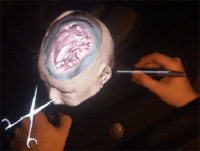Second Generation Haptic Ventriculostomy Simulator Using the ImmersiveTouch™ System
January 24th, 2006
Categories: Applications, Devices, Virtual Medicine, Visualization

Authors
Luciano, C., Banerjee, P., Lemole, M.G., Charbel, F.About
Ventriculostomy is a neurosurgical procedure that consists of the insertion of a catheter into the ventricles of the brain for relieving the intracranial pressure. A distinct “popping” sensation is felt as the catheter enters the ventricles. Early ventriculostomy simulators provided some basic audio / visual feedback to simulate the procedure, displaying a 3D virtual model of a human head. Without any tactile feedback, the usefulness of such simulators was very limited. The first generation haptic ventriculostomy simulators incorporated a haptic device to generate a virtual resistance and “give” upon ventricular entry. While this created considerable excitement as a novelty device for cannulating ventricles, its usefulness for teaching and measuring neurosurgical expertise was still very limited. Poor collocation between the haptic device stylus held by the surgeon and the visual representation of the virtual catheter, as well as the lack of a correct viewer-centered perspective, created enormous confusion for the neurosurgeons who diverted their attention from the actual ventriculostomy procedure to overcoming the limitations of the simulator. We present a second generation haptic ventriculostomy simulator succeeding over the major first generation limitations by introducing a head and hand tracking system as well as a high-resolution high-visual-acuity stereoscopic display to enhance the perception and realism of the virtual ventriculostomy.
Resources
Citation
Luciano, C., Banerjee, P., Lemole, M.G., Charbel, F., Second Generation Haptic Ventriculostomy Simulator Using the ImmersiveTouch™ System, Medicine Meets Virtual Reality 14, Long Beach, CA, January 24th, 2006.